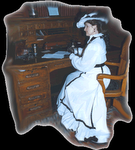
It is cold here in Colorado and I keep hearing sniffles around me everywhere I go. It's just that season of the year when being cooped up inside brings the germs and viruses out to play. I hunted back through some past columns I wrote several years ago (published in the Country Register newspaper), and decided to share one with you here:
“Visits With a Victorian Lady”TM
A Mother’s Touch
“When I was sick and lay a-bed,
I had two pillows at my head,
And all my toys beside me lay
To keep me happy all the day.”
from “The Land of Counterpane,” by Robert Louis Stevenson
Please pardon me, dear reader, for any toast crumbs or blotches of beef-tea you may find staining this missive. I am endeavoring to write to you from my daughter’s room amidst the general confusion of quilts, dolls, extra pillows, and a lap tray filled with assorted sick-day remedies. You see, Elizabeth is recovering from a bit of catarrh, that malady often referred to as a “cold.”
To counter the affect of the chill January air, I had Maude lay a nice fire in Elizabeth’s bedroom stove. Next I layered a few quilts about her, taking care not to cause her to overheat, something that “Practical Housekeeping” says predisposes one to the congestion affected in catarrh.
As a matter of course, I administered my own mother’s cure for catarrh: “put a tea-spoonful of sugar in a goblet, and on it put six drops of camphor, adding water till the glass is half full; stir, till the sugar is dissolved, then give a dessert-spoonful to the patient every twenty minutes.”
Even though constant attention to a sick child is important, an indulgent mother must ever be on the watch that the child’s illness not be the cause of spoiling. Many a child will whine and wheedle their way during sick-days in an effort to obtain things they would never dream of asking for when healthy and whole. Indeed, “Practical Housekeeping” suggests that “patients are often killed by kindness. A spoonful of improper food, or the indulgence of some whim, may prove fatal.” Even though Elizabeth begged for snow pudding the whole week, I held fast to the rule “a little food at a time and often repeated, is the general rule for the sick.” Weak beef-tea was ordered up from Martha, my cook, and administered by the spoonful every hour for the first two days of the illness.
I must admit that within the past couple of days I have indulged Elizabeth just a bit. I yielded to her pleas and we spent a good deal of the afternoon today cutting paper dolls and reading her favorite stories. Please don’t admonish me for spoiling! It is just that I am so pleased to see her progress -- the roses are back in her cheeks again. Perhaps with all your marvels of modern medicine you cannot understand my delight at something so insignificant as a child’s recovery of a “cold.” You may not know that in the 1890’s often half the children born to us never reach adulthood. Even so, these dear little ones on loan to us from God above are most special, and each day we have them is to be treasured. ~~~
~~~ Please pardon the jog in my writing. Elizabeth just pulled on my sleeve, and with earnest brown eyes, begged again for snow pudding. Hmm . . . do you know? I think she just might get some. Until next time, let me leave you with the receipt and the admonition to spoil your favorite child with “just a little.” A mother’s touch, after all, might be filled with the best sort of medicine.
Believe me to be every so sincerely yours, Abigail Bradshaw.
SNOW PUDDING
1 envelope Knox gelatin juice of one lemon
3 eggs, separated juice of one orange
1 cup sugar 1/2 pint heavy cream, whipped
a scant teaspoon of grated lemon and orange peel
Beat the egg whites and set aside. Beat egg yolks and sugar until lemon-colored. Soak gelatin in 1/2 cup cold water, heat over a pan of hot water until dissolved. Combine with the egg yolk and sugar mixture and add the juices and grated peels. Let stand until it begins to thicken. Fold in whipped cream and lastly, the beaten egg whites. Set aside in a cold place.
Copyright, 1998 - 2009, Judi Brandow, all rights reserved
* * *





No comments:
Post a Comment